Effects of Thickened Excess Sludge Pre-Treatment Using Hydrodynamic Cavitation for Anaerobic Digestion
Abstract
:1. Introduction
2. Materials and Methods
2.1. Characteristics of the Substrate
2.2. Disintegration Apparatus
2.3. Experimental Setup
- Soluble chemical oxygen demand (SCOD), volatile fatty acids (VFA), ammonium nitrogen (N-NH4+), pH, alkalinity concentrations in the filtrate (the liquid phase) before and after disintegration, as well as in digestate samples;
- Total solids (TS) and volatile solids (VS) concentrations in sludge before and after disintegration, as well as in digestate samples;
- Sludge disintegration degree (DDCOD) according to Nickel and Neis [19];
- Total activity degree of aerobic microorganisms (ADOUR) according to Zubrowska-Sudol and Walczak [18]; the determination of the index aimed at the verification whether deactivation of microorganisms present in TES occurs at a given energy density.
3. Results and Discussion
3.1. Impact of Energy Density Input on TES Characteristic
3.2. Impact of Hydrodynamic Cavitation on the Anaerobic Digestion Process
3.2.1. Changes in the Characteristics of the Liquid Phase of Sludge during the Anaerobic Digestion Process
3.2.2. Impact of Hydrodynamic Cavitation on Biogas and Methane Accumulation
3.2.3. Impact of Hydrodynamic Cavitation on Biogas and Methane Yield
4. Conclusions
Author Contributions
Funding
Conflicts of Interest
References
- Journal of Laws of the Republic of Poland. Regulation of the Minister of Economy of 16 July 2015 on Allowing Waste to be Stored on Landfills; item 1277; Journal of Laws of the Republic of Poland: Warszawa, Poland, 2015. Available online: http://prawo.sejm.gov.pl/isap.nsf/DocDetails.xsp?id=WDU20150001277 (accessed on 13 May 2020). (In Polish)
- Central Statistical Office of Poland. Environment 2018, Statistical Information and Elaborations; Central Statistical Office of Poland: Warszawa, Poland, 2018. Available online: https://stat.gov.pl/obszary-tematyczne/srodowiskoenergia/srodowisko/ochrona-srodowiska-2018,1,19.html (accessed on 13 May 2020). (In Polish)
- Polish National Waste Management Plan 2022. Polish Monitor, item 784; 11 August 2015. Available online: http://prawo.sejm.gov.pl/isap.nsf/DocDetails.xsp?id=WDU20150001277 (accessed on 13 May 2020). (In Polish)
- Zielewicz, E. Dezintegracja ultradźwiękowa i hybrydowa osadu nadmiernego; Termiczna mineralizacja osadu ściekowego. In Proceedings of the V Konferencja naukowo-techniczna, Nowogród k. Łomży, Poland, 3–5 September 2008; Seidel-Przywecki: Warszawa, Poland, 2008. (In Polish). [Google Scholar]
- Lee, I.; Han, J.I. The effects of waste-activated sludge pretreatment using hydrodynamic cavitation for methane production. Ultrason. Sonochem. 2013, 20, 1450–1455. [Google Scholar] [CrossRef]
- Petkovšek, M.; Mlakar, M.; Levstek, M.; Stražar, M.; Širok, B.; Dular, M. A novel rotation generator of hydrodynamic cavitation for waste activated sludge disintegration. Ultrason. Sonochem. 2015, 26, 408–414. [Google Scholar] [CrossRef]
- Zhao, H.; Zhang, P.; Zhang, G.; Cheng, R. Enhancement of ultrasonic disintegration of sewage sludge by aeration. J. Environ. Sci. 2016, 42, 163–167. [Google Scholar] [CrossRef]
- Jung, K.W.; Hwang, M.J.; Yun, Y.M.; Cha, M.J.; Ahn, K.H. Development of a novel electric field-assisted modified hydrodynamic cavitation system for disintegration of waste activated sludge. Ultrason. Sonochem. 2014, 21, 1635–1640. [Google Scholar] [CrossRef]
- Patil, P.N.; Gogate, P.R.; Csoka, L.; Dregelyi-Kiss, A.; Horvath, M. Intensification of biogas production using pretreatment based on hydrodynamic cavitation. Ultrason. Sonochem. 2016, 30, 79–86. [Google Scholar] [CrossRef]
- Peng, L.; Appels, L.; Su, H. Combining microwave irradiation with sodium citrate addition improves the pre-treatment on anaerobic digestion of excess sewage sludge. J. Environ. Manag. 2018, 213, 271–278. [Google Scholar] [CrossRef]
- Lippert, T.; Bandelin, J.; Musch, A.; Drewes, J.E.; Koch, K. Energy-positive sewage sludge pre-treatment with a novel ultrasonic flatbed reactor at low energy input. Bioresour. Technol. 2018, 264, 298–305. [Google Scholar] [CrossRef]
- Houtmeyers, S.; Degrève, J.; Willems, K.; Dewil, R.; Appels, L. Comparing the influence of low power ultrasonic and microwave pre-treatments on the solubilisation and semi-continuous anaerobic digestion of waste activated sludge. Bioresour. Technol. 2014, 171, 44–49. [Google Scholar] [CrossRef]
- Liu, X.; Xu, Q.; Wang, D.; Zhao, J.; Wu, Y.; Liu, Y.; Yang, Q. Improved methane production from waste activated sludge by combining free ammonia with heat pretreatment: Performance, mechanisms and applications. Bioresour. Technol. 2018, 268, 230–236. [Google Scholar] [CrossRef]
- Li, X.; Liu, Y.; Xu, Q.; Liu, X.; Huang, X.; Yang, J.; Yang, Q. Enhanced methane production from waste activated sludge by combining calcium peroxide with ultrasonic: Performance, mechanism, and implication. Bioresour. Technol. 2019, 279, 108–116. [Google Scholar] [CrossRef]
- Zielewicz, E. Disintegration of sludge in the context of biogas growth. Gaz Woda i Technika Sanitarna 2016, 90, 69–75. (In Polish) [Google Scholar] [CrossRef]
- Zielewicz, E. Disintegration of excess sludge to support the methane fermentation process-theory and practice. Gaz Woda i Technika Sanitarna 2014, 4, 138–143. (In Polish) [Google Scholar]
- Zubrowska-Sudol, M.; Walczak, J. Enhancing combined biological nitrogen and phosphorus removal from wastewater by applying mechanically disintegrated excess sludge. Water Res. 2015, 76, 10–18. [Google Scholar] [CrossRef]
- Zubrowska-Sudol, M.; Walczak, J. Effects of mechanical disintegration of activated sludge on the activity of nitrifying and denitrifying bacteria and phosphorus accumulating organisms. Water Res. 2014, 61, 200–209. [Google Scholar] [CrossRef]
- Nickle, K.; Neis, U. Ultrasonic disintegration of biosolids for improved biodegradation. Ultrason. Sonochem. 2007, 14, 450–455. [Google Scholar] [CrossRef]
- Standard Methods for the Examination of Water and Wastewater; American Public Health Association/American Water Works Association/Water Environment Federation: Washington DC, USA, 1998.
- Wang, F.; Wang, Y.; Ji, M. Mechanisms and kinetics models for ultrasonic waste activated sludge disintegration. J. Hazard. Mater. 2005, 123, 145–150. [Google Scholar] [CrossRef]
- Appels, L.; Baeyens, J.; Degrève, J.; Dewil, R. Principles and potential of the anaerobic digestion of waste-activated sludge. Prog. Energy Combust. Sci. 2008, 34, 755–781. [Google Scholar] [CrossRef]
- Luste, S.; Luostarinen, S. Anaerobic co–digestion of meat–processing by–products and sewage sludge–effect of higienization and organic loading rate. Bioresour. Technol. 2010, 101, 2657–2664. [Google Scholar] [CrossRef]
- Montusiewicz, A. Współfermentacja Osadów ściekowych i Wybranych kosubstratów Jako Metoda Efektywnej Biometanizacji; Monografie Komitetu Inżynierii Środowiska PAN: Lublin, Poland, 2012; Volume 98. (In Polish) [Google Scholar]
- Bień, J.; Wystalska, K. Osady ściekowe. Teoria i praktyka; Wydawnictwo Politechniki Częstochowskiej: Częstochowa, Poland, 2011. (In Polish) [Google Scholar]
- Lizama, A.C.; Figueiras, C.C.; Herrera, R.R.; Pedreguera, A.Z.; Espinoza, J.E.R. Effects of ultrasonic pretreatment on the solubilization and kinetic study of biogas production from anaerobic digestion of waste activated sludge. Int. Biodeterior. Biodegrad. 2017, 123, 1–9. [Google Scholar] [CrossRef]
- Koch, K.; Lippert, T.; Drewes, J.E. The role of inoculum’s origin on the methane yield of different substrates in biochemical methane potential (BMP) tests. Bioresour. Technol. 2017, 243, 457–463. [Google Scholar] [CrossRef]
- Rani, R.U.; Kumar, S.A.; Kaliappan, S.; Yeom, I.; Banu, J.R. Impacts of microwave pretreatments on the semi-continuous anaerobic digestion of dairy waste activated sludge. Waste Manag. 2013, 33, 1119–1127. [Google Scholar] [CrossRef]
- Zeynali, R.; Khojastehpour, M.; Ebrahiminik, M. Effect of ultrasonic pre-treatment on biogas yield and specific energy in anaerobic digestion of fruit and vegetable wholesale market wastes. Sustain. Environ. Res. 2017, 27, 259–264. [Google Scholar] [CrossRef]
- Gil, A.; Siles, J.A.; Martín, M.A.; Chica, A.F.; Estévez-Pastor, F.S.; Toro-Baptista, E. Effect of microwave pretreatment on semi-continuous anaerobic digestion of sewage sludge. Renew. Energy 2018, 115, 917–925. [Google Scholar] [CrossRef]
- Zhen, G.; Lu, X.; Li, Y.Y.; Zhao, Y. Combined electrical-alkali pretreatment to increase the anaerobic hydrolysis rate of waste activated sludge during anaerobic digestion. Appl. Energy 2014, 128, 93–102. [Google Scholar] [CrossRef]
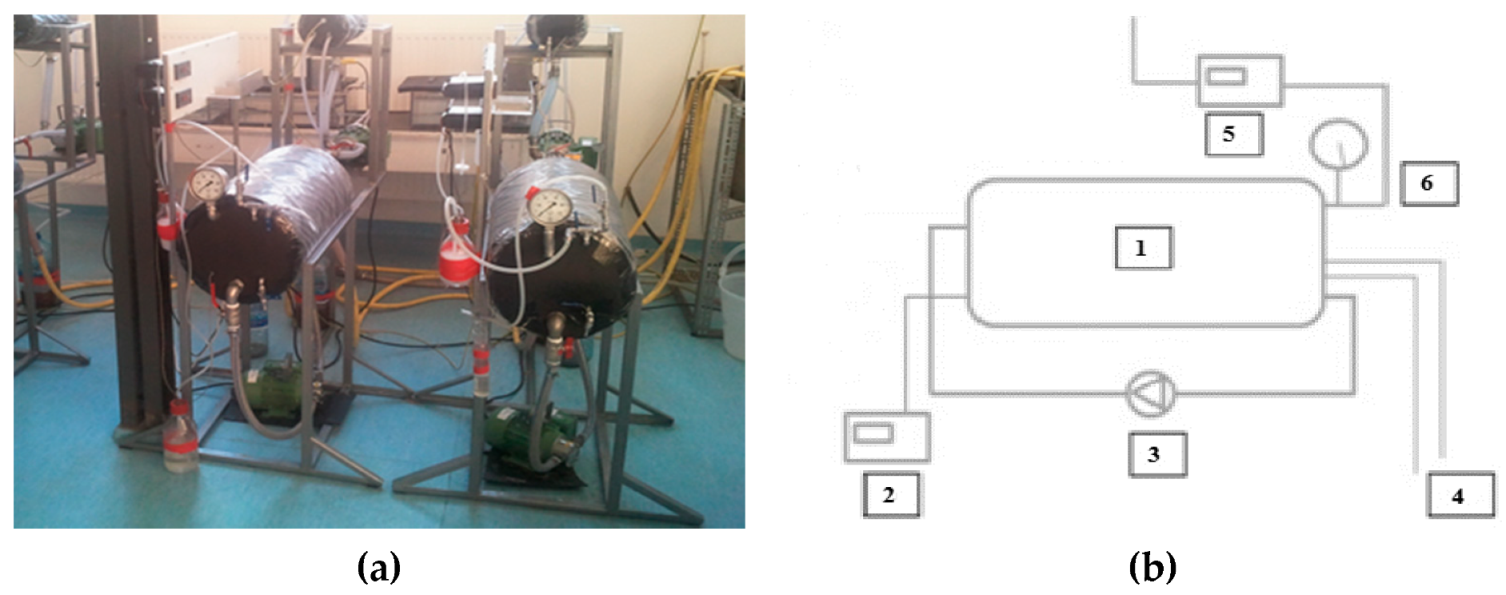
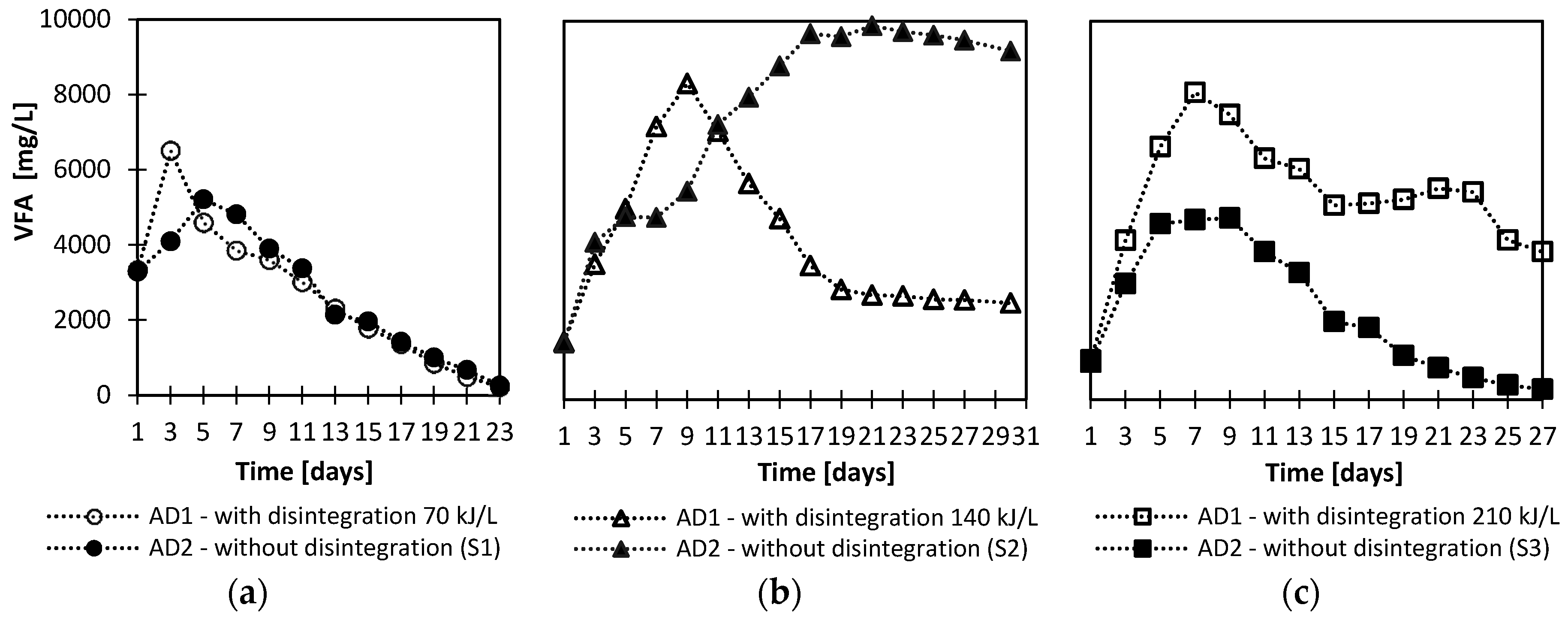
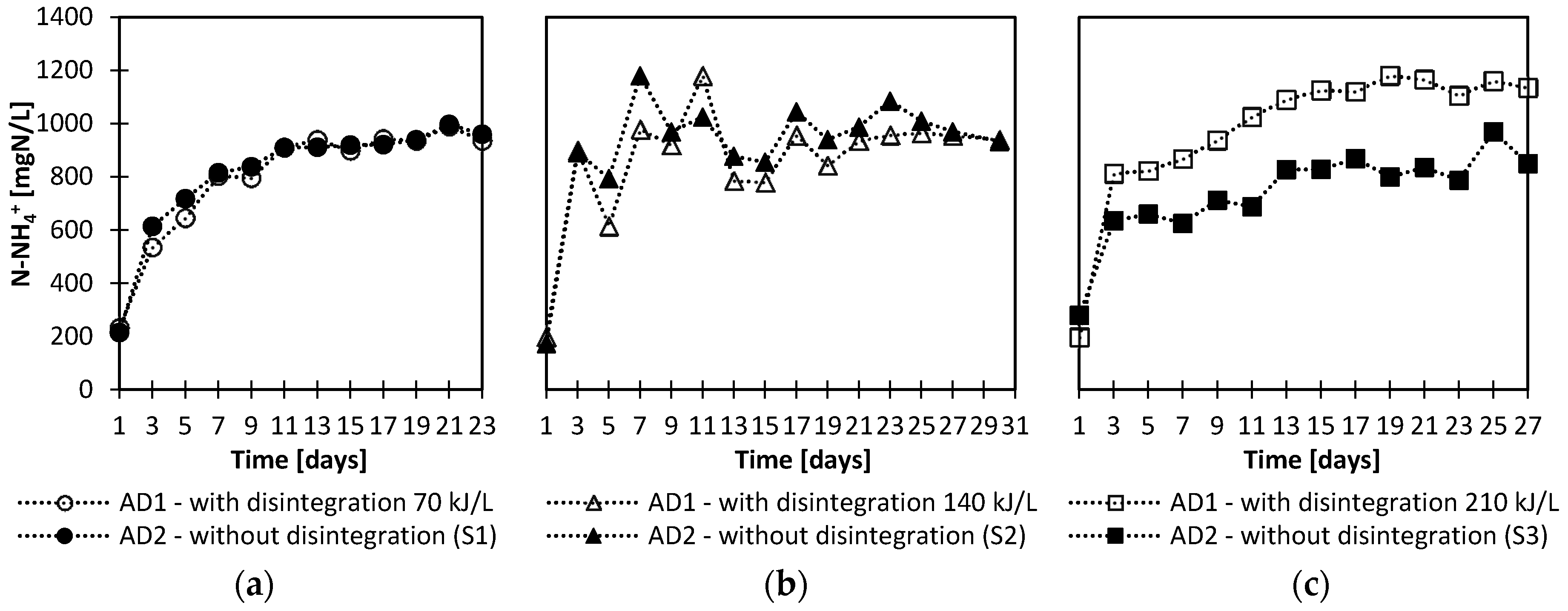
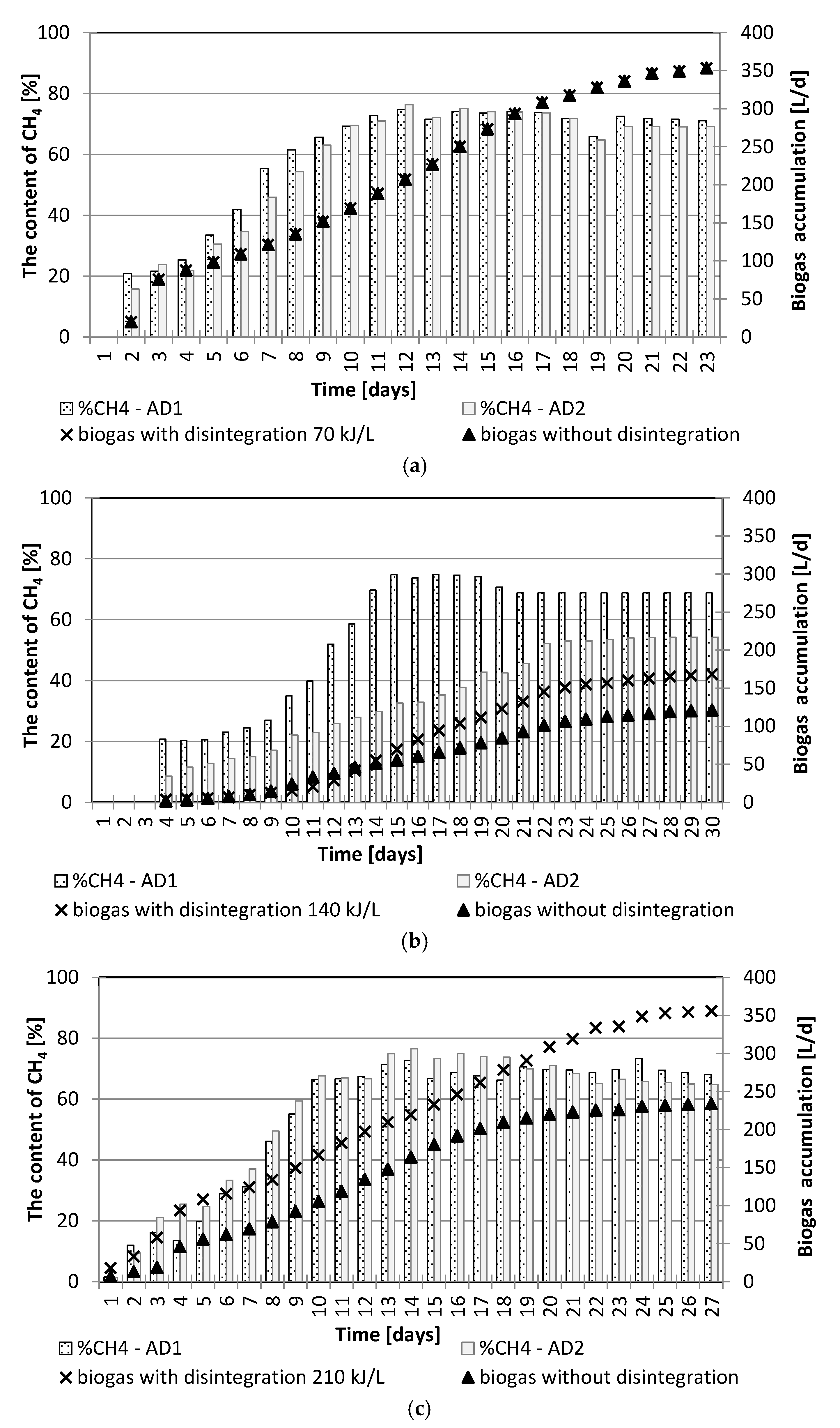
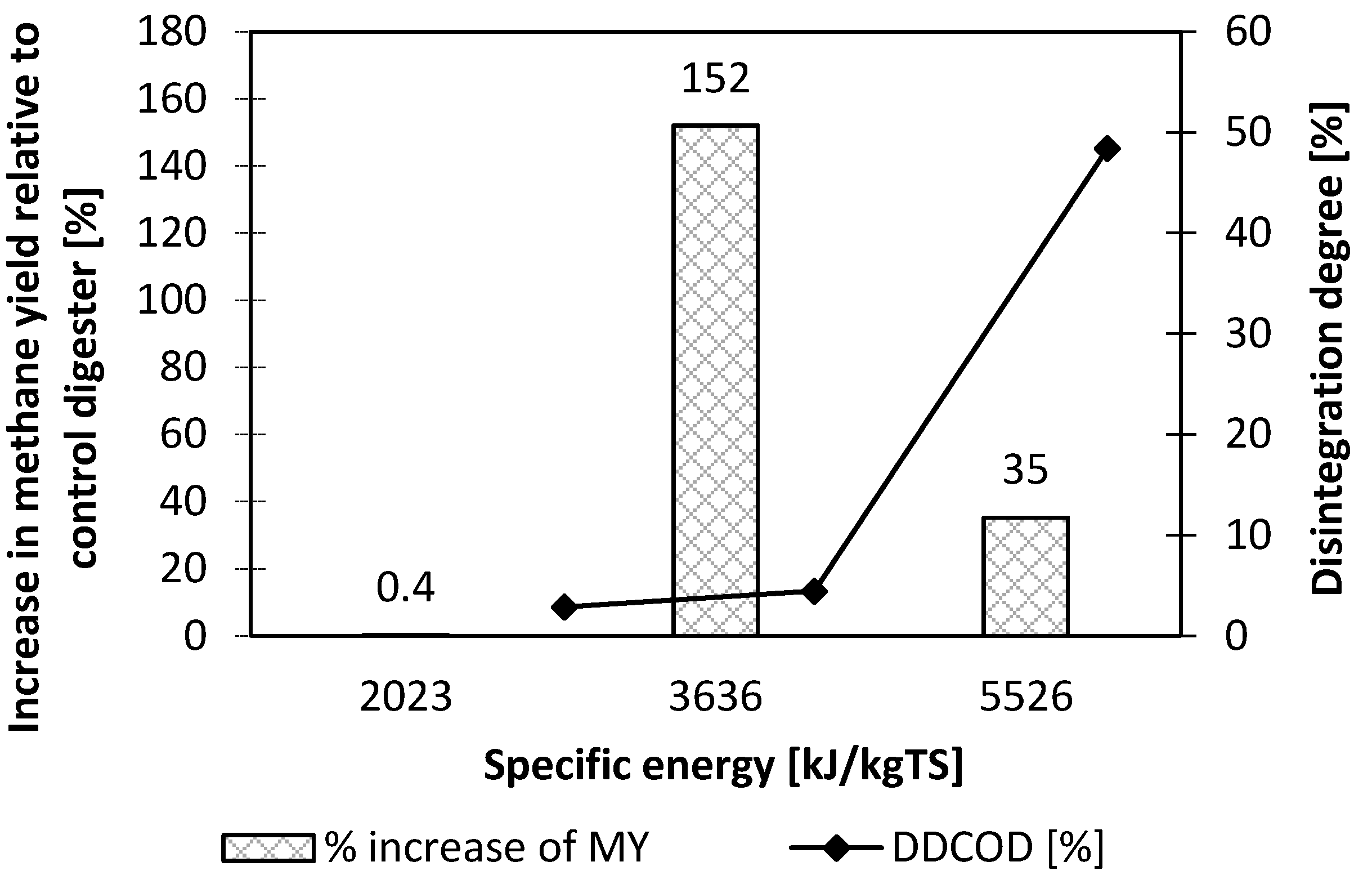
| Indicators | Unit | TPS 2 | TES 3 | DS 4 |
|---|---|---|---|---|
| Total solids 1 | [g/L] | 50.4–64.4 | 34.6–39.7 | 26.5–28.9 |
| Volatile solids 1 | [g/L] | 41.0–50.9 | 24.3–29.8 | 16.5–19.1 |
| SCOD 1 | [mg/L] | 3420–3925 | 117–261 | 288–421 |
| VFA 1 | [mg/L] | 1215–2422 | 26–31 | 36–55 |
| HRT 1 | [d] | - | - | 22–26 |
| Digester temperature | [°C] | - | - | 36 |
| Indicators | Unit | Series 1 | Series 2 | Series 3 | |||
|---|---|---|---|---|---|---|---|
| Raw TES 1 | Dez.70 kJ/L 2 | Raw TES1 | Dez.140 kJ/L 3 | Raw TES 1 | Dez.210 kJ/L 4 | ||
| SCOD | [mg/L] | 155 | 455 | 117 | 1755 | 261 | 5810 |
| VFA | [mg/L] | 28 | 103 | 31 | 282 | 26 | 1418 |
| pH | [-] | 7.7 | 7.6 | 8.8 | 8.0 | 8.3 | 6.8 |
| DDCOD | [%] | - | 1.4 | - | 4.5 | - | 48 |
| ADOUR | [%] | - | 10 | - | −4.0 | - | −89 |
| Series | Time of Anaerobic Digestion Process [days] | |||||||||||||||
|---|---|---|---|---|---|---|---|---|---|---|---|---|---|---|---|---|
| 1 | 3 | 5 | 7 | 9 | 11 | 13 | 15 | 17 | 19 | 21 | 23 | 25 | 27 | 30 | ||
| S1 1 | AD1 | 0.5 | 0.9 | 0.7 | 0.5 | 0.5 | 0.4 | 0.3 | 0.2 | 0.2 | 0.1 | 0.1 | 0.0 | - | - | - |
| AD2 | 0.5 | 0.5 | 0.7 | 0.6 | 0.5 | 0.4 | 0.2 | 0.2 | 0.1 | 0.1 | 0.1 | 0.0 | - | - | - | |
| S2 1 | AD1 | 0.2 | 0.3 | 0.6 | 0.7 | 0.8 | 0.7 | 0.6 | 0.5 | 0.3 | 0.3 | 0.2 | 0.2 | 0.2 | 0.2 | 0.2 |
| AD2 | 0.1 | 0.2 | 0.3 | 0.3 | 0.3 | 0.4 | 0.5 | 0.5 | 0.6 | 0.6 | 0.6 | 0.5 | 0.5 | 0.5 | 0.5 | |
| S3 1 | AD1 | 0.1 | 0.4 | 0.7 | 0.8 | 0.8 | 0.6 | 0.6 | 0.5 | 0.5 | 0.5 | 0.5 | 0.5 | 0.4 | 0.3 | - |
| AD2 | 0.1 | 0.3 | 0.5 | 0.6 | 0.5 | 0.4 | 0.4 | 0.2 | 0.2 | 0.1 | 0.1 | 0.1 | 0.0 | 0.0 | - | |
| Indicators | Unit | AD1-S1 | AD2-S1 | AD1-S2 | AD2-S2 | AD1-S3 | AD2-S3 |
|---|---|---|---|---|---|---|---|
| EL = 70 kJ/L | - | EL = 140 kJ/L | - | EL = 210 kJ/L | - | ||
| biogas yield | [L/gVSfed] | 0.477 | 0.468 | 0.194 | 0.142 | 0.439 | 0.287 |
| increase of BY relative to control digester | [%] | 2.0 | 37 | 53 | |||
| methane yield | [L/gVSfed] | 0.273 | 0.272 | 0.126 | 0.050 | 0.218 | 0.161 |
| increase of MY relative to control digester | [%] | 0.4 | 152 | 35 | |||
| Parameters | Unit | AD1-S2 | AD1-S3 |
|---|---|---|---|
| EL = 140 kJ/L | EL = 210 kJ/L | ||
| Increase in methane production | [m3] | 0.063 | 0.044 |
| Energy content of extra methane1 | [KWh] | 0.253 | 0.176 |
| Energy applied | [KWh] | 0.529 | 0.758 |
| Net energy production | [KWh] | −0.276 | −0.582 |
© 2020 by the authors. Licensee MDPI, Basel, Switzerland. This article is an open access article distributed under the terms and conditions of the Creative Commons Attribution (CC BY) license (http://creativecommons.org/licenses/by/4.0/).
Share and Cite
Garlicka, A.; Zubrowska-Sudol, M.; Umiejewska, K.; Roubinek, O.; Palige, J.; Chmielewski, A. Effects of Thickened Excess Sludge Pre-Treatment Using Hydrodynamic Cavitation for Anaerobic Digestion. Energies 2020, 13, 2483. https://doi.org/10.3390/en13102483
Garlicka A, Zubrowska-Sudol M, Umiejewska K, Roubinek O, Palige J, Chmielewski A. Effects of Thickened Excess Sludge Pre-Treatment Using Hydrodynamic Cavitation for Anaerobic Digestion. Energies. 2020; 13(10):2483. https://doi.org/10.3390/en13102483
Chicago/Turabian StyleGarlicka, Agnieszka, Monika Zubrowska-Sudol, Katarzyna Umiejewska, Otton Roubinek, Jacek Palige, and Andrzej Chmielewski. 2020. "Effects of Thickened Excess Sludge Pre-Treatment Using Hydrodynamic Cavitation for Anaerobic Digestion" Energies 13, no. 10: 2483. https://doi.org/10.3390/en13102483
APA StyleGarlicka, A., Zubrowska-Sudol, M., Umiejewska, K., Roubinek, O., Palige, J., & Chmielewski, A. (2020). Effects of Thickened Excess Sludge Pre-Treatment Using Hydrodynamic Cavitation for Anaerobic Digestion. Energies, 13(10), 2483. https://doi.org/10.3390/en13102483







